Sync your Trafft appointments seamlessly with your Outlook Calendar to manage your schedule effortlessly. With the Outlook Calendar integration, you can avoid double bookings between your work and personal commitments. Any appointments created in Trafft will automatically appear in your Outlook Calendar, ensuring your availability is always up-to-date. Likewise, any busy slots marked in your Outlook Calendar will be blocked off in Trafft, preventing overlapping appointments. Whether you reschedule or delete an appointment in Outlook, Trafft will reflect these changes instantly, keeping your schedules in sync across platforms.
Activating and Configuring the Google Calendar Synchronization
To set up the integration, head to the Features & Integrations in your Trafft account. Look for the "Outlook Calendar and Microsoft Teams" integration and activate it by simply clicking the "Enable" button.
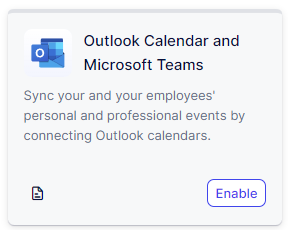
After activation, the card will refresh, showing a "Set Up" button. Click on this button to proceed to the configuration page for the Outlook Calendar and Microsoft Teams integration.
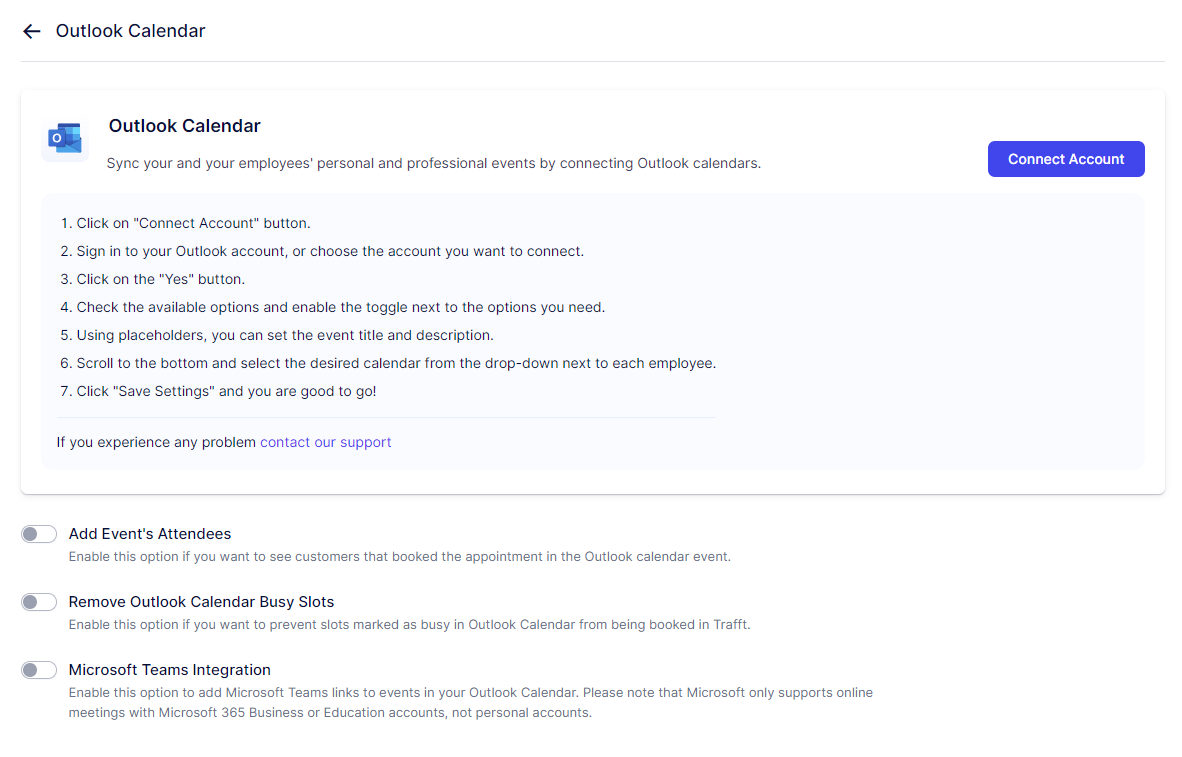
When you access the Outlook Calendar and Microsoft Teams integration page for the first time, you’ll see the screenshot displayed above which provides short instructions on how you can connect your account. Depending on your organization’s setup, there are two ways to use this integration:
- Link the Main Account: Click on the “Connect Account” button in the top right corner to link your main (admin) Outlook account with Trafft. This allows you to select calendars created in the linked Outlook account and assign them to your employees, who will be listed below the Event Title and the Event Description sections (shown after the account is connected).
- Link via Account Settings: You can keep the integration enabled without connecting the main account through this page. Instead, you (and your employees) can connect to Outlook Calendar through the Account Settings. This allows you to link up to 6 Outlook accounts (per employee) and select multiple calendars from these accounts. These calendars can then be used to block availability in Trafft.
Regardless of the method you choose, you and your employees will be able to connect multiple calendars.
Initially, only three sliders are available ("Add Event's Attendees", "Remove Outlook Calendar Busy Slots", and "Microsoft Teams Integration") but once an account is connected, additional two options will be added ("Include Buffer Times in Outlook events" and "Insert Pending Appointments").
Before diving into the detailed instructions for both approaches, let’s cover the settings that will assist you in configuring Outlook synchronization to align with your specific needs.
- Insert Pending Appointments: This option, disabled by default, includes appointments with “Pending” status alongside “Approved” status appointments in the calendar.
- Add Event’s Attendees: Useful for group bookings, it shows all attendees (customers) within the Outlook Event.
- Please Note: The Outlook Invitation emails will be sent only if this option is enabled.
- Remove Outlook Calendar Busy Slots: Enabling this blocks slots marked as busy in your Outlook Calendar, preventing them from being booked in Trafft.
- Include Buffer time in Outlook Events: This setting determines if the event attendees will see only the original duration of appointments or also the buffer time before and/or after the appointment.
- Microsoft Teams Integration: When enabled, Trafft integrates with Microsoft Teams. Appointments for employees connected to Microsoft will have the option to be held online, and the Microsoft Teams link will automatically be added to their Outlook Calendar.
Event Title and Event Description
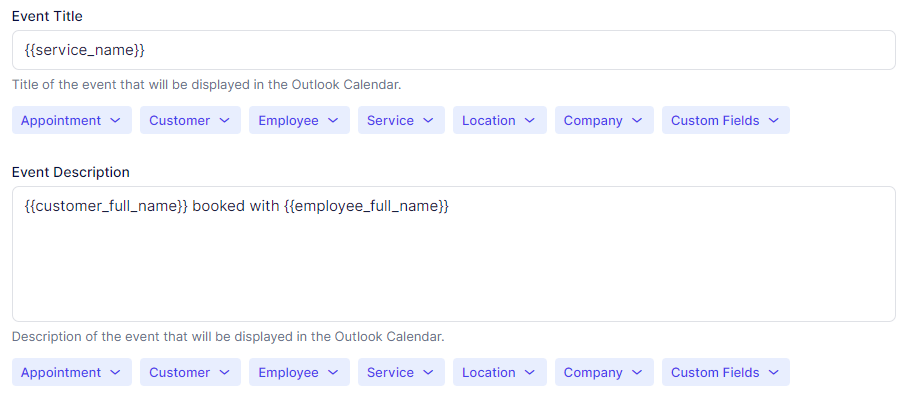
These two options provide you with the flexibility to personalize the Event title and description in the Outlook Calendar Event created from Trafft Appointments. This customization allows you to tailor the displayed information for each appointment. Here's how you can personalize these fields using a combination of text and placeholders:
- Event Title: Begin by placing your cursor inside the "Event Title" field. From there, select the information you wish to display in the Event title from the dropdown menu below the field. By default, the {{service_name}} placeholder is included in the title, but you can also add custom text and additional placeholders as needed.
- Event Description: Similarly, you can customize the "Event Description" field. Place your cursor inside this field and choose the desired information from the dropdown menu to include in the Event description. The Event Description field starts blank, allowing you to add specific details or additional placeholders as required.
Utilizing placeholders enables you to dynamically insert information into the Event title and description. This feature allows you to create personalized and informative Event titles and descriptions, providing essential details at a glance.
Linking the Main Account
Connecting the main account is ideal for solopreneurs or organizations managing calendars for multiple employees within a single Outlook account.
After linking the account through the primary Outlook Calendar settings page, all the employees you've created will be listed beneath the Event Title and Event Description sections:
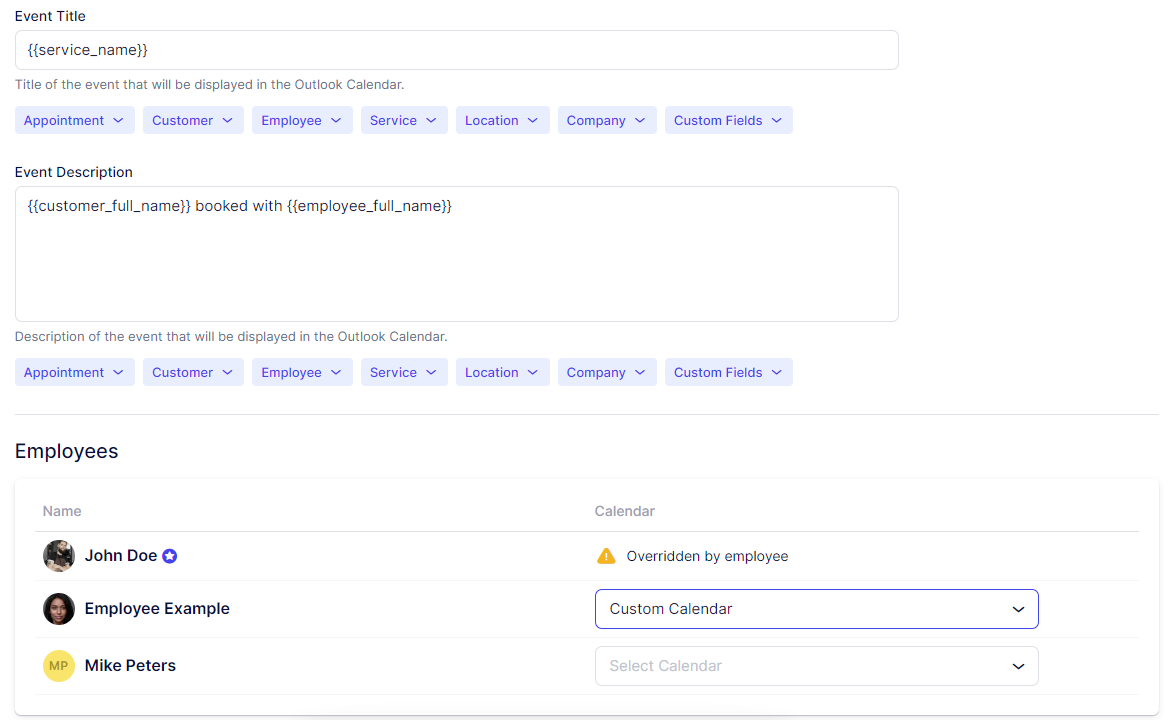
The screenshot above illustrates three different scenarios related to employees' connections with Outlook Calendar:
- "Mike Peters" is currently not linked to any Outlook accounts.
- "Employee Example" is connected through the Outlook Calendar integration page.
- "John Doe" is linked to his personal calendar through Account Settings.
Upon linking the account, all employees will initially appear below the Event Title and Event Description with a blank dropdown menu, as seen with "Mike Peters" in the screenshot above.
If you decide to assign a calendar to an employee, the dropdown will expand and display all the calendars created in the Outlook Account linked with Trafft. The assignment of one of these calendars to an employee is demonstrated by "Employee Example" in the screenshot above. Once an employee is linked in this way, they will not be able to connect their personal Outlook accounts through Account Settings/Integrations. If they attempt to access this section, they will see the following notification:
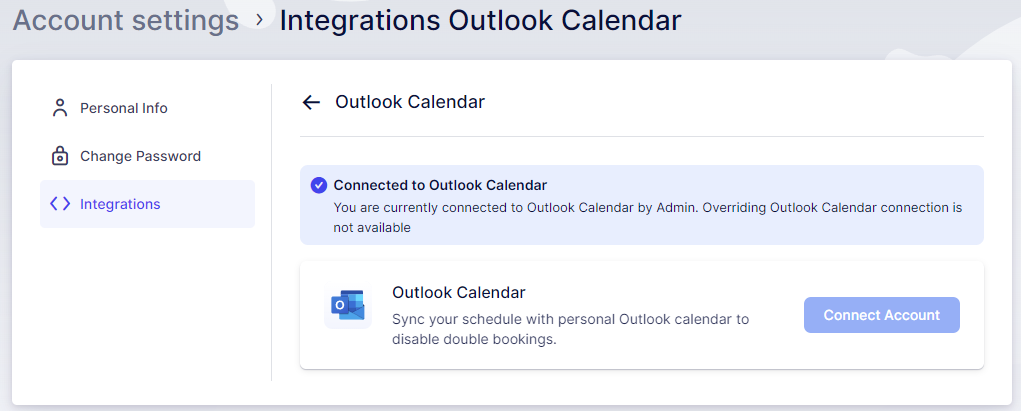
This message simply notifies the employee that the admin has linked their employee profile with one of the Outlook Calendars existing in the admin’s Outlook account. As a result, the employee will not be able to click on the “Connect Account” button. If the employee needs to log into their Outlook account, the admin would need to return to the Outlook Calendar and Microsoft Teams integration page, hover over the dropdown next to this employee, and click on the “X” button to remove the connection. After saving these settings, the employee will be able to log into their calendar.
Enabling the employee to log into their calendar ("John Doe" in the screenshot above) effectively covers the "Linking via Account Settings" method. Please continue reading to learn how to proceed with this option.
Linking via Account Settings
The "Overridden by Employee" option, seen next to "John Doe" in the screenshot above (where three employees are listed), indicates that the Outlook Calendar connection was not established through the Outlook Calendar and Microsoft Teams integration page, but that the employee has overridden it. This occurs when the employee logs into their Outlook Account through the Account Settings.
This approach is designed to ensure that employees have control over their calendar integration settings, even though the Admin or Superadmin may have initially connected the main account. Since the Admin or Superadmin does not have access to the login information for the employee's personal Outlook account, the employee is given the ability to manage their own calendar integration.
After the employee's account is created by the Admin or Superadmin, their login must be enabled for Trafft. Here's how you can do it:
- Navigate to the "Settings" section located in the lower left corner of Trafft’s admin page.
- Click on "Users and Roles" on the new page that appears.
- Next to the employee you want to enable the login for, click on the three-dots menu -> Enable Login.
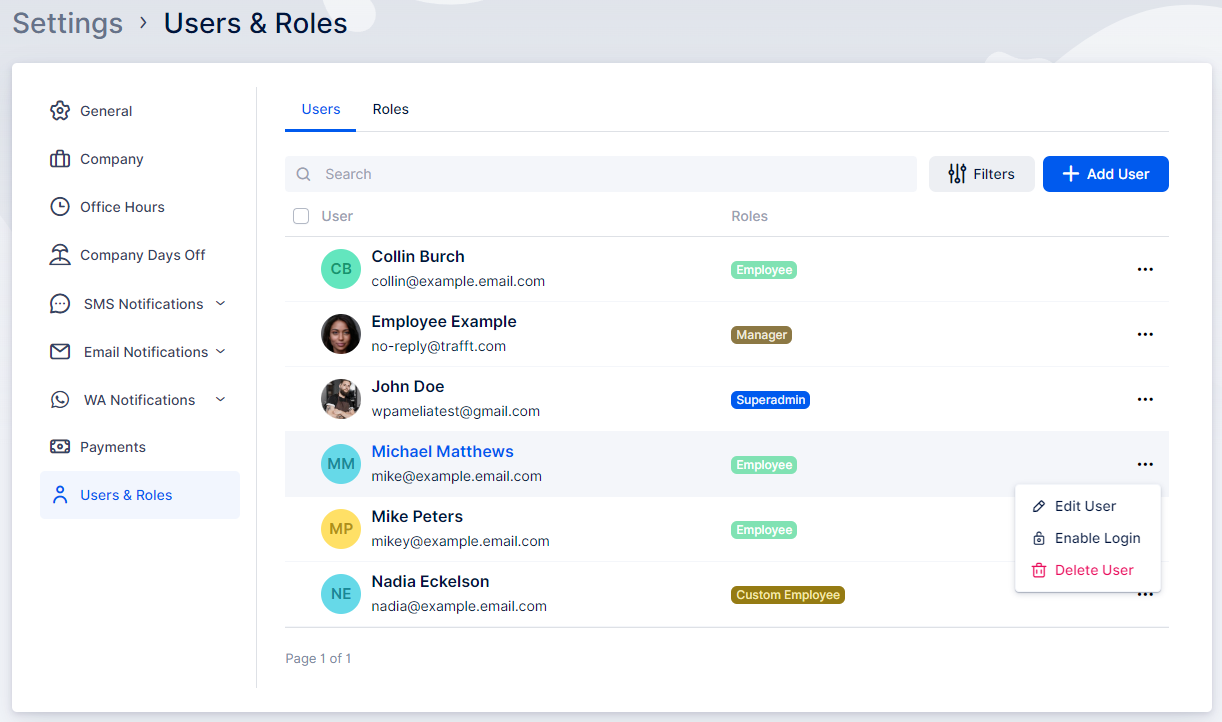
In a new popup that appears, you can choose whether Trafft will auto-generate a password or if you prefer to create a password manually for this employee. Below that, you can also define whether the employee will be required to choose a new password on the first login or if you’ll only send the login information to the user.
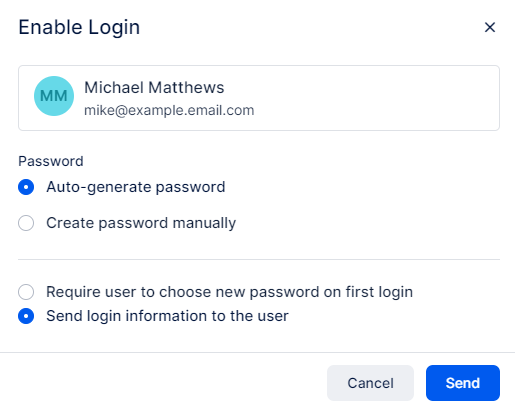
Upon receiving their login information, the employee can then access their Trafft account. They should proceed to Account Settings to link their Outlook account with their employee profile in Trafft.
To access the Account Settings, simply click on the name located in the top right corner:
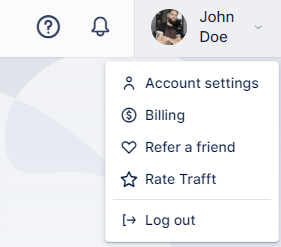
This action will open a new window where the logged-in employee can modify their personal details, update their password, and manage their schedule (if their user role permits). Crucially for this integration, they can navigate to the Integrations section and log into their personal Outlook account.
To access the Integrations section, simply click on "Outlook Calendar".
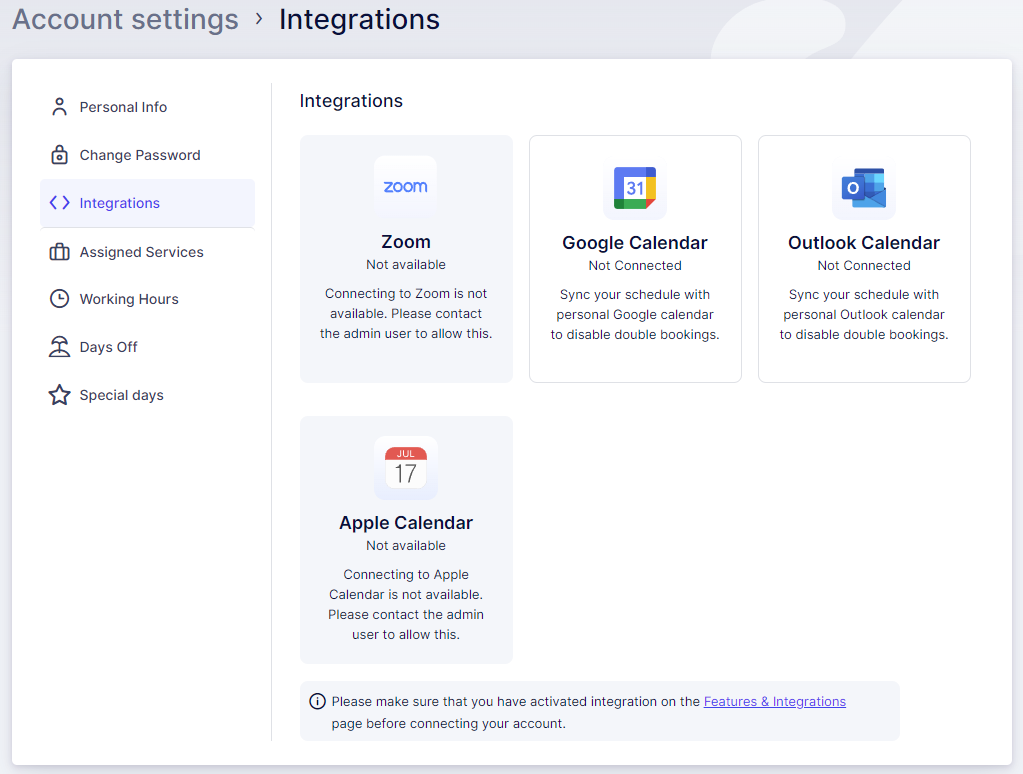
In the Integrations section, click on “Connect Account”. Trafft will then redirect you to the Outlook log-in page where you'll need to select your Outlook account. Upon selection, Outlook will display a prompt warning that you are granting Trafft access to certain information. You must allow all necessary permissions to proceed with the integration.
Once Trafft has been granted access to your Outlook account, you'll be redirected back to the Account Settings/Integrations page. Here, you will find that your account is now successfully connected. Illustrated in the screenshot below, you will have the following options:
- Add Another Account: An employee can add multiple accounts to select calendars that should block times in Trafft. You can add up to six accounts.
- Sync with: Choose one of the connected calendars where all scheduled appointments from Trafft will be added. You can only select one account for this option.
- Block time from calendars: Select multiple calendars from which busy time slots will be blocked off in Trafft. You can add a maximum of six accounts by clicking “Add Calendar”. For example, if you have a business calendar and a private calendar, adding both here will make all busy time slots in both calendars unavailable in Trafft.
- Insert Pending Appointments: By default, once the employee links their Outlook account, the default settings made in the Outlook Calendar and Microsoft Teams integration page will not be pulled, so the employee needs to choose whether they’ll include Pending appointments made in Trafft in their Outlook Calendar.
- Include Buffer time in Outlook events: Similarly, this option is not inherited from Outlook Calendar global settings, so the employee can choose whether they want buffer time added to the events created by Trafft or not.
- Event Title and Event Description: This option also doesn’t pull the setup from the global settings, so the employee will need to populate the Event Title and the Event Description here.
- Remember to click "Save" to save your settings.
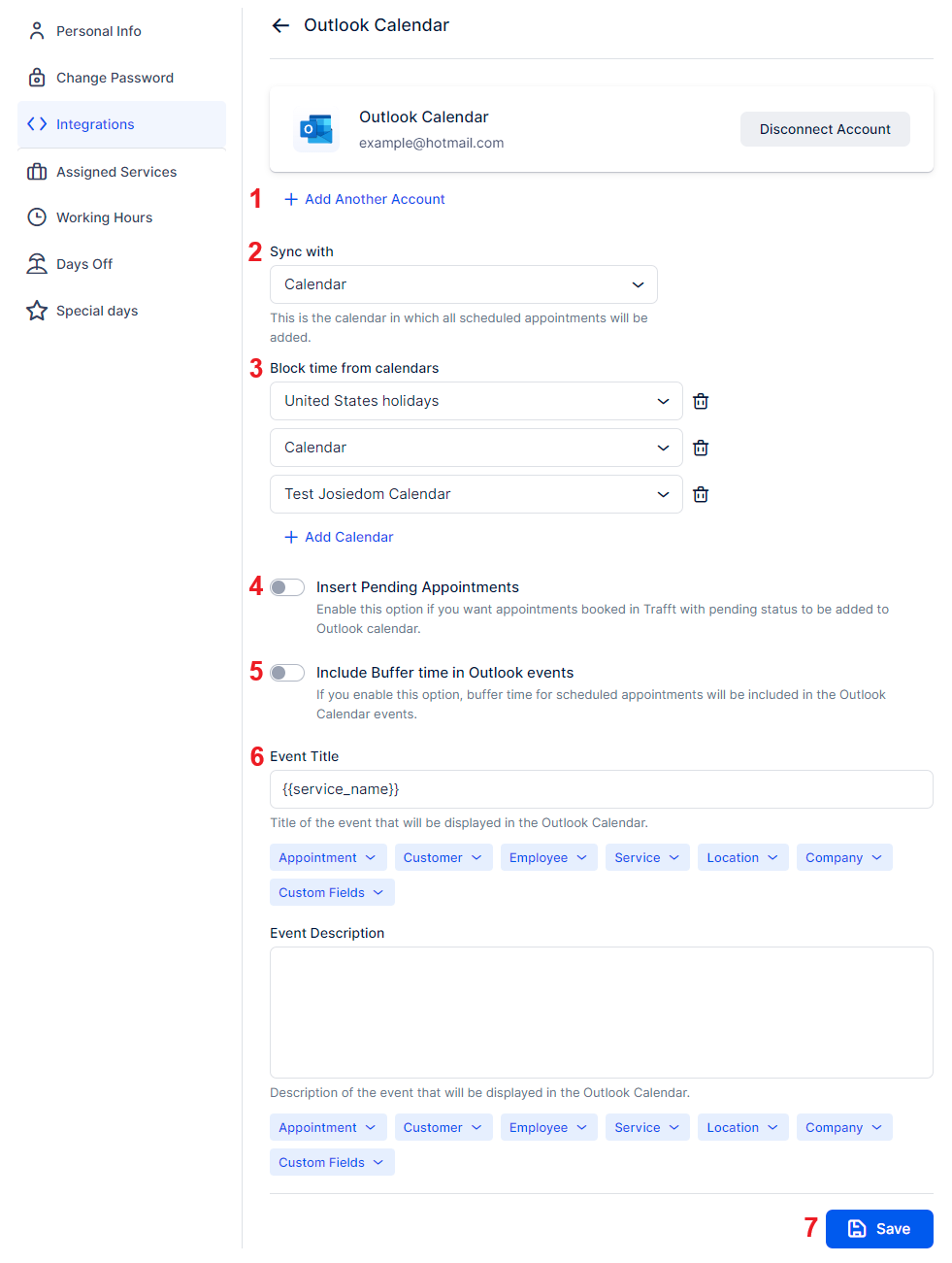
Microsoft Teams
To enable the Microsoft Teams integration, it must first be activated in the global settings. Access this through Features & Integrations -> Outlook Calendar and Microsoft Teams -> "Set Up". Scroll down to find the "Microsoft Teams Integration" slider and enable it.
Once activated, Trafft may display a yellow warning above the employees list, indicating that there are employees connected to Outlook Calendar who have not set Online Meetings as the location. To address this, click on the "Go to Employees" button, which will direct you to the Employees section, our next step regardless.
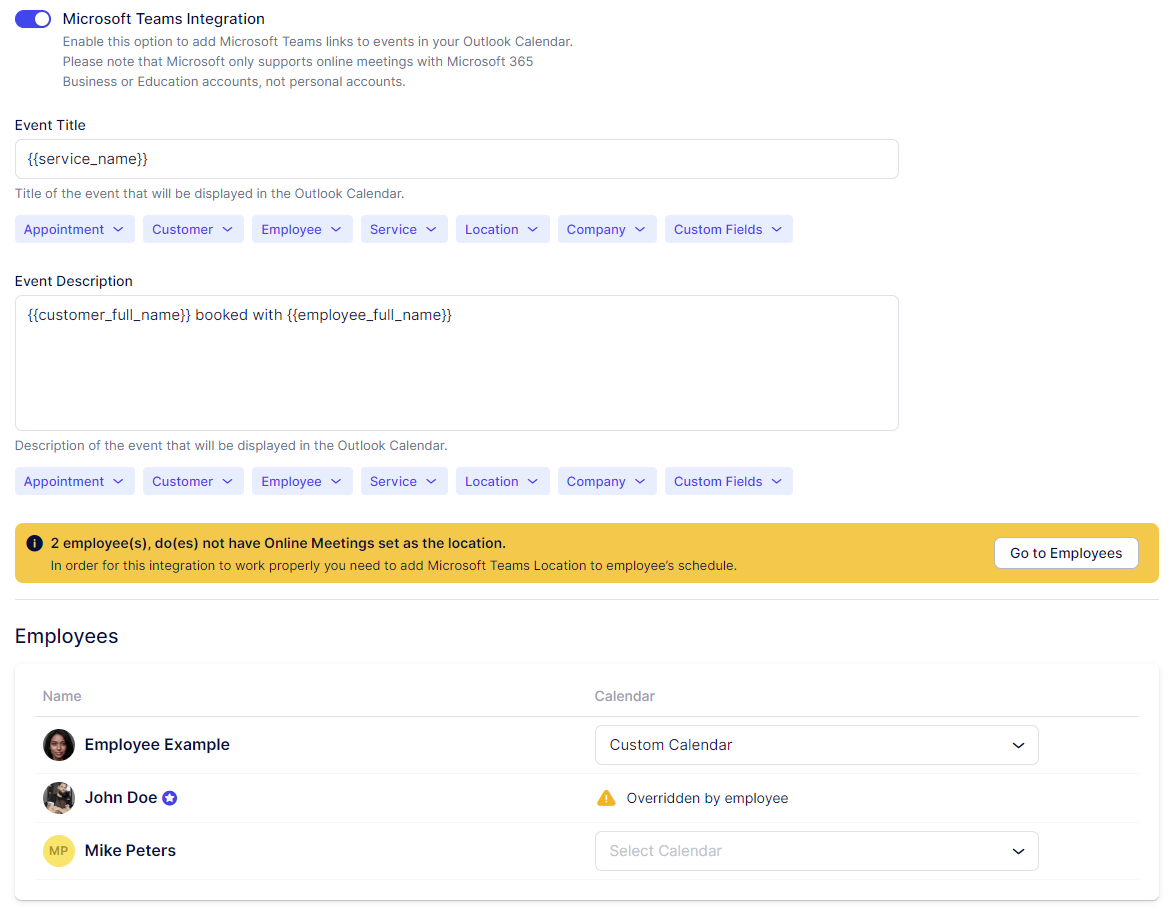
Once you're in the "Employees" section, locate the employee you wish to edit, then click on the three-dots menu -> Edit Employee. This will open the employee’s profile where you can change the default location. Select "Microsoft Teams" as the location for online meetings:
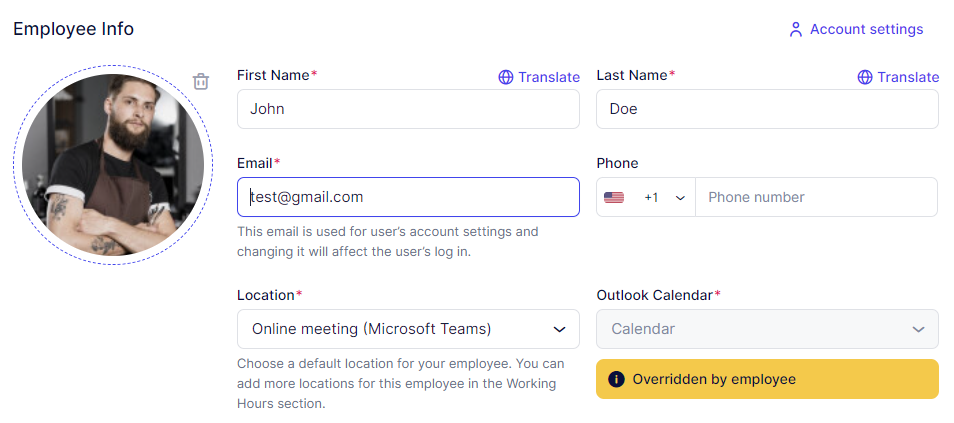
Please note that setting "Microsoft Teams" as the default location for an employee does not automatically make them available for booking via Microsoft Teams. You also need to ensure their Working Hours and Service locations are correctly configured.
Working Hours: In the employee’s profile, navigate to the “Working Hours” tab and verify their schedule. If you have manually set different locations for their working hours, you will need to adjust these accordingly. Here's an example:
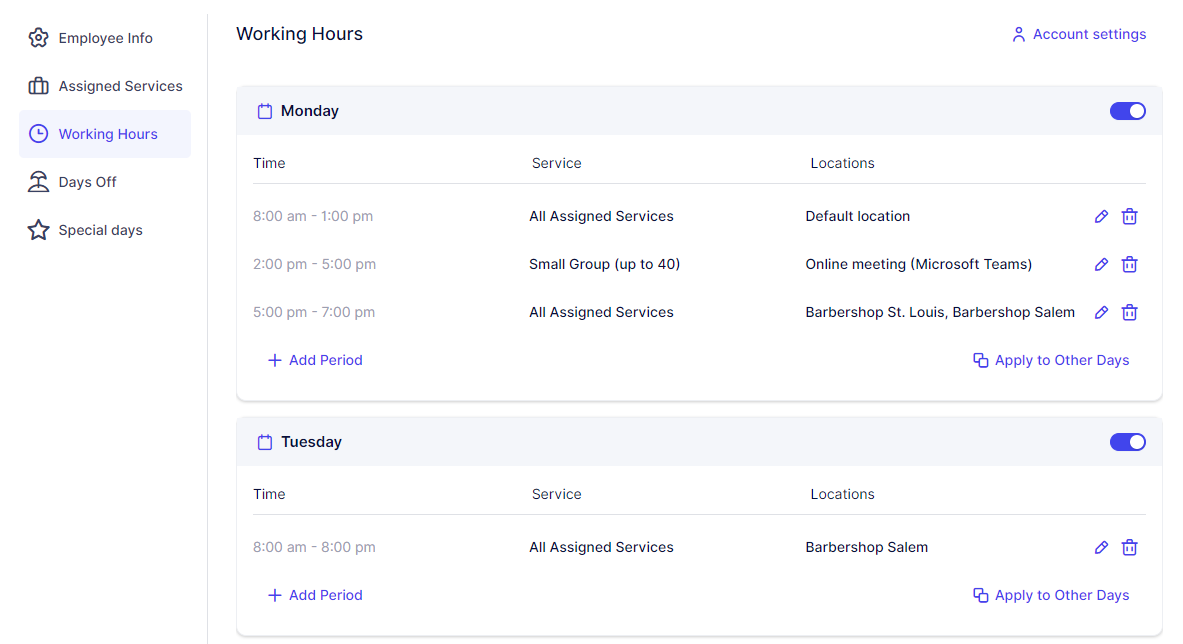
In this case, the employee will cover the Default Location (that doesn't have to be Microsoft Teams, depending on your configuration) on Mondays, but only from 08:00 am - 1:00 pm, then he's covering Microsoft Teams exclusively from 2:00 pm - 5:00 pm (this means that the employee will always cover Microsoft Teams even if the default location is changed), and finally, he covers two physical locations from 5:00 pm - 7:00 pm. As showcased in the screenshot above, you can select multiple locations during the employee’s working hours, and you can create multiple working periods so the employee covers different locations per period.
Tuesdays aren't configured for Microsoft Teams in this case, so if the default location in the employee's profile is not Microsoft Teams, it will not be available on Tuesdays.
Next, let's ensure that the services you want to offer via Microsoft Teams are properly configured.
Services: Navigate to the Services section and select the service you wish to provide via Microsoft Teams. Inside the service details, go to the "Settings" tab on the left-hand side and check the "Where do you want to provide the service" option.
- Selecting "Online" or "All Locations" will enable appointments for this service to be conducted via Microsoft Teams.
- Choosing "On-Site" will indicate that this service should not be offered via Microsoft Teams, limiting it to physical locations only.
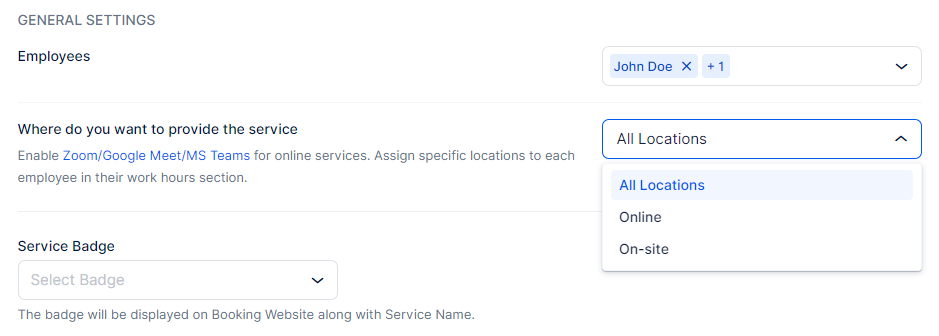
After ensuring the employee’s working hours and service availability, you are all set to utilize Microsoft Teams.
When scheduling new appointments, a distinct Microsoft Teams meeting link will be generated. For Group Appointments, the same link will be shared among all participants.
Key Points to Remember
This essentially wraps up the Outlook Calendar and Microsoft Teams integration. Here are the key points to understand how it functions:
Have more questions
If you face an issue, and cannot find an answer in the documentation, feel free to submit a support ticket!
Contact us